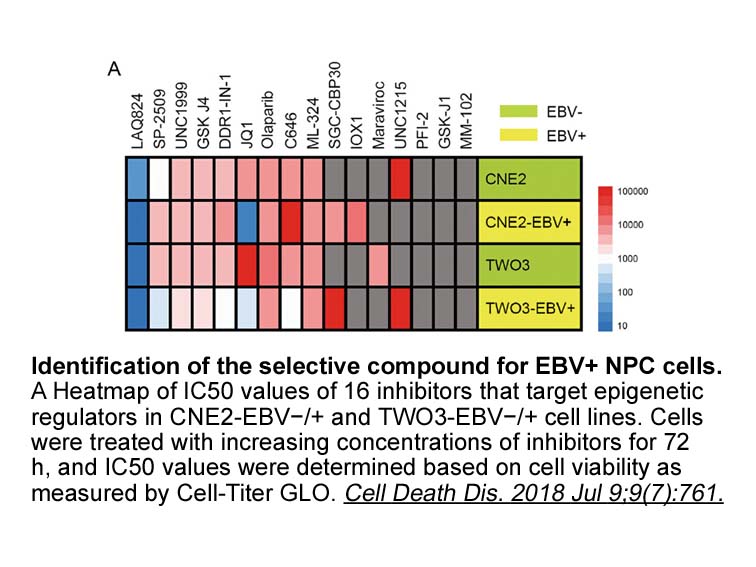Archives
- 2025-12
- 2025-11
- 2025-10
- 2025-09
- 2025-03
- 2025-02
- 2025-01
- 2024-12
- 2024-11
- 2024-10
- 2024-09
- 2024-08
- 2024-07
- 2024-06
- 2024-05
- 2024-04
- 2024-03
- 2024-02
- 2024-01
- 2023-12
- 2023-11
- 2023-10
- 2023-09
- 2023-08
- 2023-07
- 2023-06
- 2023-05
- 2023-04
- 2023-03
- 2023-02
- 2023-01
- 2022-12
- 2022-11
- 2022-10
- 2022-09
- 2022-08
- 2022-07
- 2022-06
- 2022-05
- 2022-04
- 2022-03
- 2022-02
- 2022-01
- 2021-12
- 2021-11
- 2021-10
- 2021-09
- 2021-08
- 2021-07
- 2021-06
- 2021-05
- 2021-04
- 2021-03
- 2021-02
- 2021-01
- 2020-12
- 2020-11
- 2020-10
- 2020-09
- 2020-08
- 2020-07
- 2020-06
- 2020-05
- 2020-04
- 2020-03
- 2020-02
- 2020-01
- 2019-12
- 2019-11
- 2019-10
- 2019-09
- 2019-08
- 2019-07
- 2018-07
-
p is a tumor suppressor gene that
2019-10-05

p16 is a tumor-suppressor gene that inhibits cyclin-dependent kinase 4 and 6 activities and arrests the LY2603618 in the G1 phase. Aberrant methylation and mutation of p16/MTS1 in OSCC of patients was found in our previous study. Moreover, the frequency of hypermethylation of p16 from the present s
-
br E mediated E discharge E
2019-10-04

E3-mediated E2 discharge E3 ligases simultaneously interact with the substrate and the SUMOD charged E2 enzyme to catalyze the discharge of the thioester-bound SUMOD from the E2 to the substrate. E3 interaction with SUMOD via a SIM results in a closed conformation which is highly reactive and lea
-
The collagen binding membrane proteins discoidin
2019-10-04

The collagen-binding membrane proteins, discoidin domain receptors 1 and 2 (DDR1 and DDR2) belong to the family of receptor tyrosine kinase and are expressed in a variety of mammalian cells.7, 8 These transmembrane glycoproteins (∼125 kDa) have been found to be over-expressed or atypically expressed
-
Apparently no study has been undertaken
2019-10-04

Apparently, no study has been undertaken on alterations in cholinesterase activity and its correlation with neurological disorders in clinical case of trypanosomosis in buffaloes. Therefore, the present study was undertaken to evaluate the alterations in cholinesterase activity in clinical cases of
-
Immune modulation by steroid hormones is
2019-10-04

Immune modulation by steroid hormones is a rather new aspect of the research on endocrine interactions in lower vertebrates (Harris and Bird, 2000). In the classical view, steroids exert their effects by binding to specific intracellular receptors that function as ligand-activated transcriptional re
-
Colistin Sulfate br Ultrasonic pretreatment of substrates Su
2019-10-04

Ultrasonic pretreatment of substrates Substrate pretreatment is widely used in the biofuel, textile and food industries since the substrates are always difficult to degrade. During some enzymatic hydrolysis reactions, the protective layer of the substrate impedes the reaction. Ultrasonic treatmen
-
Like all other cellular processes ubiquitination is also tig
2019-10-04

Like all other cellular processes, ubiquitination is also tightly regulated; more so, as myriads of pathways are controlled via this conjugation and dysregulation of ubiquitination has been implicated in various diseases including cancer [16], [17]. Quite a few of such regulatory mechanisms that con
-
Enolases are among the most abundantly expressed cytosolic p
2019-10-02

Enolases are among the most abundantly expressed cytosolic proteins. They are metalloenzymes that catalyze the conversion of 2-phosphoglycerate to phosphoenolpyruvate [18]. Eubacteria and archaebacteria have a single enolase gene (reviewed in [19]). Despite the lack of signal peptides or cognate pro
-
The potent estrogen EE induced a decrease in CYP C
2019-10-02

The potent L-703,664 succinate kinase EE2 induced a decrease in CYP2C11 activity (reduction in 2α-OH and 16α-OH testosterone) and protein at the 200 ppb dose and in this respect was similar to nonylphenol and genistein. This result agrees qualitatively with the results of Hallstrom et al. (1996) who
-
br Acknowledgments This work was supported
2019-10-02

Acknowledgments This work was supported by Grants from the National Research Foundation (2010-0000782) and the National Center for GM Crops (PJ008152) of the Next Generation BioGreen 21 Program funded by the Rural Development Administration, Republic of Korea, to W.T.K. Introduction Ubiquityl
-
br Acknowledgements The study of RING type E
2019-10-02

Acknowledgements The study of RING-type E3s continues to grow extremely rapidly. We regret that it was possible to only cite a fraction of the outstanding primary publications in this field. This work was supported by the National Institute of General Medical Sciences grants R01 GM088055 and R01
-
br Conclusion br Conflict of interest br
2019-10-02

Conclusion Conflict of interest Acknowledgment The authors acknowledge the grant support of the Tehran University of Medical Sciences (94-02-49-29647). Introduction Earlier in vitro observations have also established that the human 5-HT2A, while very similar to the rat isoform, exhibits
-
AS 101 During germ cell development in mouse de novo
2019-10-02

During germ cell development in mouse, de novo Dnmts regulate the genomic imprinting and silence of repeat elements. Dnmt3A methylated H19, Dlk1/Gtl2, and Sine B1, whereas Dnmt3B methylated microsatellite repeat elements, the two Dnmts co-methylatedRasgrf1, IAP, and Line1 repeat elements (Lucifero e
-
br Experimental Procedures br Acknowledgments br Introductio
2019-10-02

Experimental Procedures Acknowledgments Introduction Incessant consumption of fossil fuels brings on global energy crisis and serious environmental concerns. Hence, the researchers have paid considerable attention to alternative renewable bioenergy. Microalgae has been considered as potenti
-
br Third trimester crossing the threshold to immunocompetenc
2019-10-02

Third trimester – crossing the threshold to immunocompetence Summary Regrettably, studies on the fetal immune system have yet to yield practical results. While it is becoming apparent that the fetal immune response plays a role in determining the outcome of congenital CMV infection, we still l
14729 records 947/982 page Previous Next First page 上5页 946947948949950 下5页 Last page